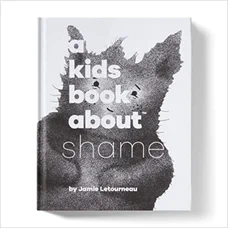A Kids Book About Shame

Recommended Age Range: 2nd through 5th, or even 6th grade.
Publisher's Summary:
This is a book about shame. Yep, that messy thing we all carry but we all like to hide. But shame is such an important topic to talk about, especially with kids. Because guess what? They feel it all the time. And they just don’t know how to talk about it. Because even grownups don’t know how to talk about it. Shame doesn’t make us anything less than enough. It just makes us human.

Dr. Annie's Takeaways
Recommended for: This book is best for a more mature, verbal child who has some insight into their thoughts and feelings. It takes seriously the intensity of children’s feelings of shame and helps kids to recognize and name the feeling, as well as to share about what is causing them to feel shame. This book is appropriate for a child who has experienced trauma or abuse and is subsequently feeling shame, as well as a child who struggles more generally with feelings of inadequacy or negative self-talk. (It makes a nod to shame sometimes being the result of “something we did or didn’t do,” as well as “something done to us.”)
Would a child like it? This book is intense, but in a good way. A child who is being weighed down by shame will feel very seen by this book. A child who wants to be taken more seriously by the adults in their lives will appreciate the respect this book has for the intensity of children’s feelings. Some (mostly younger) children will be put off by the relative lack of pictures or story–this book isn’t great for them.
Tone: Heartfelt, intense, reassuring
Story Quality: This book describes shame using impactful, poetic language (“Sometimes shame feels like playing hide-and-seek but not wanting to be found…Shame feels like you’re dirty and broken on the inside and outside”). It speaks directly to the child reading it, and reassures them that they are not alone. It’s very well written.
Illustrations: The illustrations are emotionally-resonant, somewhat abstract, black-and-white drawings (they almost remind me of Rorschach inkblots). Shame is depicted as a fuzzy, shy animal-like creature. Many of the pages don’t have an illustration accompanying them; instead the text functions as the illustration with an effective use of font size, style, and placement.
Representation: This book does not include any mention of identity markers (gender, race, etc.). It speaks to “you” and shares messages that are universally applicable to children. There’s a line that states “Moms, dads, siblings, friends, teachers…even your dog sometimes feel shame.”
Psychological Practices: This book helps children to develop an understanding of the feeling of shame so they are able to recognize the feeling and name it (“Shame is a tricky feeling that crawls into our brains and our hearts that makes us feel icky, like we’re not enough: not nice enough, brave enough, happy enough, smart enough…”). The primary message is that shame is universal and sharing about it will “set it free.” It encourages children to talk with someone about their shame, or if they’re not ready for that, to draw, write, dance, jump, sing, and swing. It emphatically insists that the child reading the book “is enough. Your whole entire self. Every little bit.”
Concerns: None
Buy This Book:
Amazon
